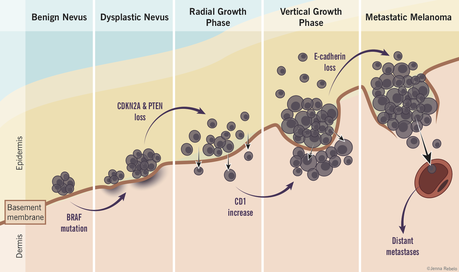
The melanoma cells have high capacity stem. Behave just like normal stem cells: they are able to maintain the growth and renewal of the tumor. That's why melanoma patients, while undergoing surgery to remove the tumor, often fail to permanently eradicate the tumor.
The tumor cells are removed in full proliferative activity, then there is still a reserve stem cell that can regenerate, either locally or in other districts, melanoma.
Researchers Italian Institute Toscano Tumori (ITT) in collaboration with non-profit organization FiorGen Florence, were able to understand, at least in part, how it works and where it comes from the ability of stem cells to melanoma.
The growth and maintenance depends strongly on the HEDGEHOG-GLI signaling pathway during embryonic development and which is inactive in adults.
It can be reactivated, and thanks to this step, the researchers were able to understand that the SOX2 gene is closely related to this biochemical pathway. SOX2 is the target gene.
To reach this conclusion, the procedure was as follows:
1 - inject human melanoma cells in laboratory animal
2 - mute, via gene silencing, the activity of SOX2
3 - note that rooting and growth of subcutaneous melanoma is abolished.
Then it became clear to researchers that SOX2 plays a critical role in self-renewal and maintenance of human melanoma, which is closely tied to its behavior as a mediator of the street HEDGEHOG - GLI.
These results give hope of future progress with regard to the gene therapy of melanoma. Mainly due to the particular characteristics of the oncogene SOX2, such as transcription factor stem, these properties can be exploited.
Fonte:
http://www.molecularlab.it/news/view.asp?n=8288
SOX2: Cellule staminali del Melanoma
Uno dei tumori della pelle più aggressivi è il melanoma.
Le cellule del melanoma hanno alta capacità staminale. Si comportano proprio come cellule staminali normali: sono in grado di mantenere la crescita e il rinnovamento del tumore. Ecco perchè i pazienti affetti da melanoma, pur sottoponendosi ad interventi chirurgici per eliminare la neoplasia, spesso non riescono a debellare in maniera definitiva il tumore.
Le cellule tumorali vengono tolte in piena attività proliferativa, quindi permane una riserva staminale che può rigenerare, localmente o in altri distretti, il melanoma.
I ricercatori italiani dell'Istituto Toscano Tumori (ITT) in collaborazione con FiorGen Onlus Firenze, sono riusciti a capire, almeno in parte, come funziona e da dove arriva la capacità staminale delle cellule di melanoma.
La crescita e il mantenimento dipende fortemente dalla via biochimica HEDGEHOG-GLI durante lo sviluppo embrionale e la quale è inattiva negli adulti.
Essa può essere riattivata, e proprio grazie a questo passaggio, i ricercatori sono stati in grado di capire che il gene SOX2 è strettamente legato a questa via biochimica. SOX2 è il gene bersaglio.
Per raggiungere questa conclusione, il procedimento è stato il seguente:
1 - iniettare cellule di melanoma umano in animale da laboratorio
2 - silenziare, tramite il silenziamento genico, l'attività di SOX2
3 - rilevare che attecchimento e crescita dei melanomi sottocute è abolito.
Quindi è risultato chiaro agli studiosi che SOX2 gioca un ruolo fondamentale nell'auto-rinnovamento e nel mantenimento del melanoma umano, strettamente legato al suo comportamento come mediatore della via HEDGEHOG - GLI.
Questi risultati fanno sperare in progressi futuri per quanto riguarda la terapia genica del melanoma. Soprattutto grazie alle particolari caratteristiche dell'oncogene SOX2, come fattore trascrizionale staminale, potranno essere sfruttate tali proprietà.





